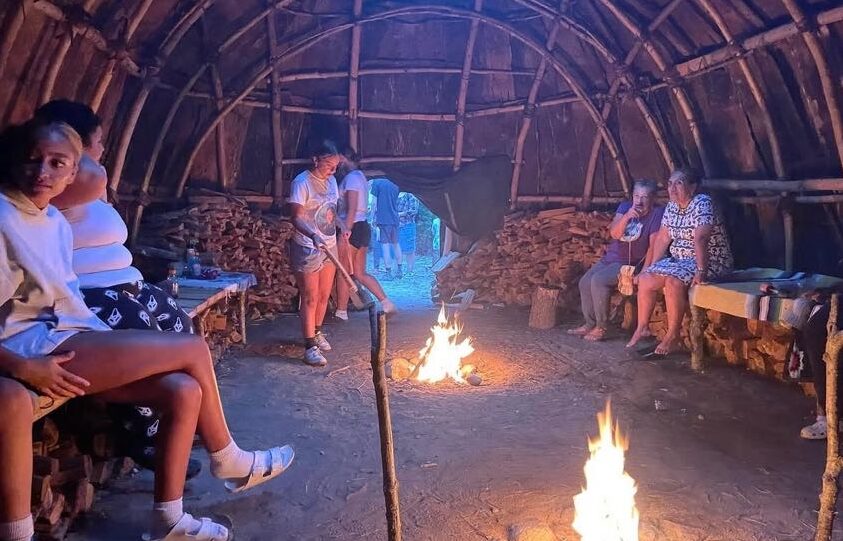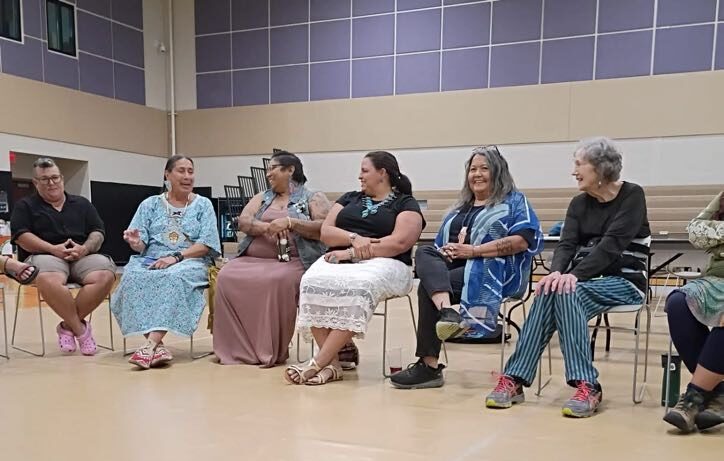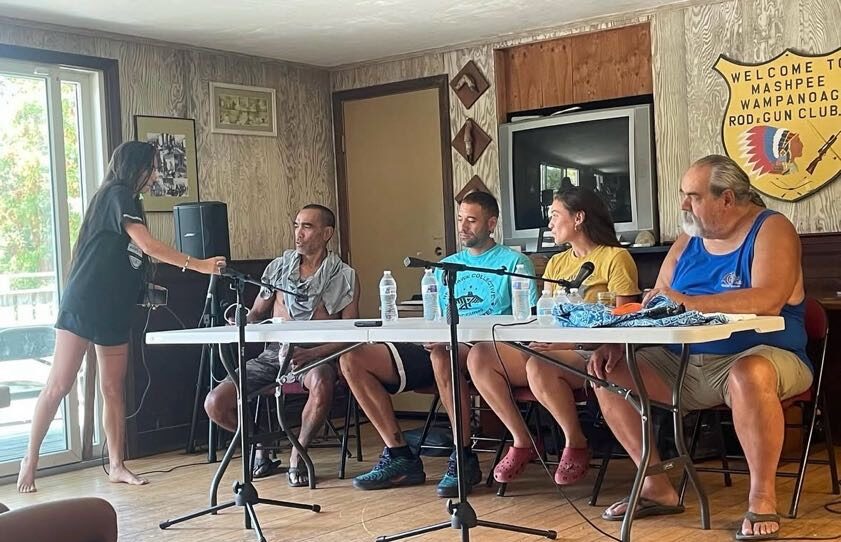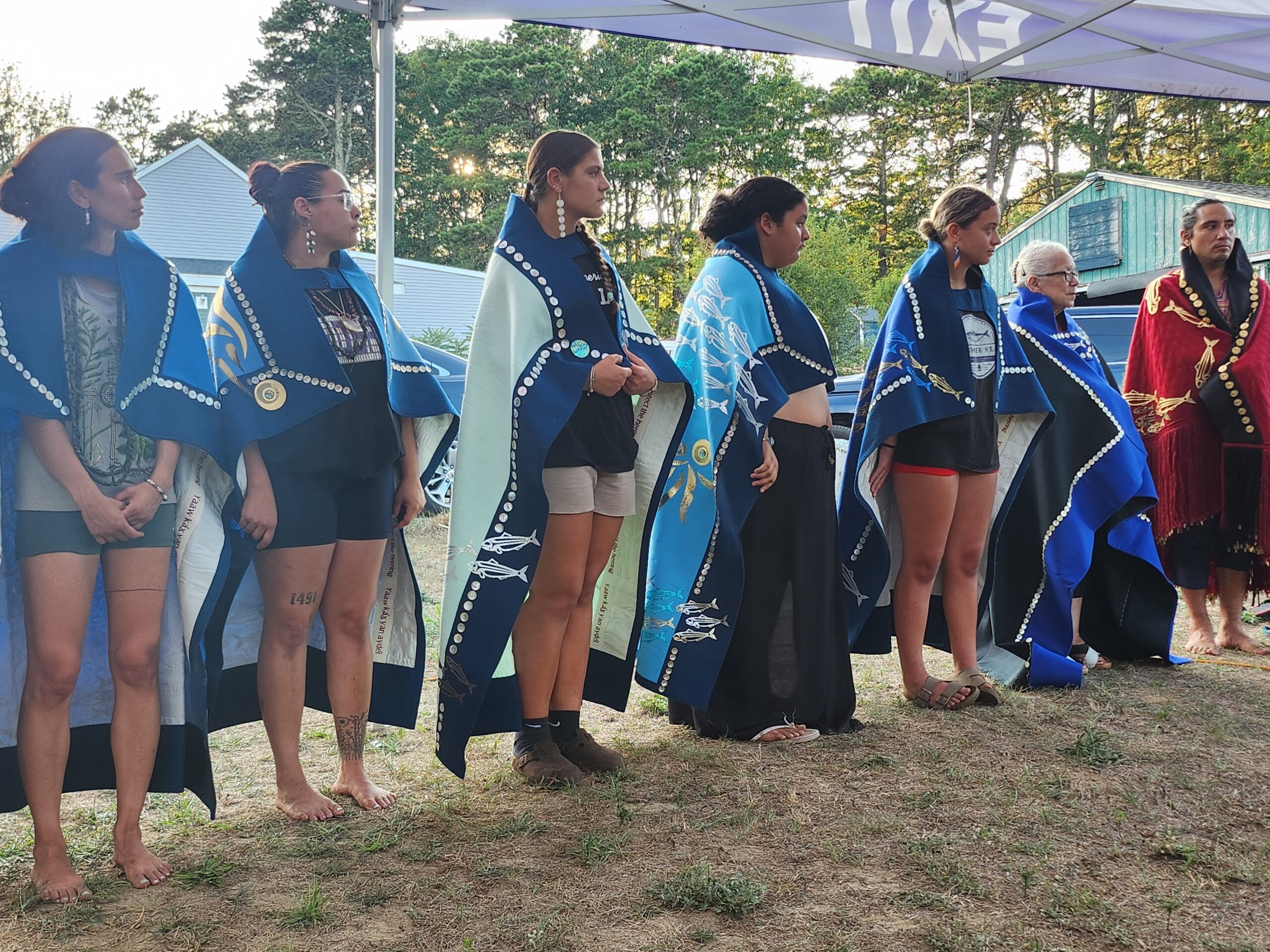Youth Lead the Way: Mashpee Gathering Sparks a Movement for the Rights of Nature
Bioneers | Published: October 16, 2025 Indigeneity Article
Although young people cannot vote, they are realizing that they can organize, legislate, and build grassroots momentum for a future where our laws honor people’s rights to a clean ecosystem and nature’s right to thrive.
In 2023, a group of Mashpee Wampanoag youth formed the Native Environmental Ambassadors (NEA), to advocate on behalf of their ancestral lands and waters.
They sat with elders and culture keepers who reminded them that there was a time, not very long ago, when plants and animals were abundant. They were devastated by the stark contrast between the elders’ recollections and the state of their homelands today.

The group’s first efforts focused on protecting herring, a keystone species along the Eastern seaboard. Once abundant, herring populations are now at 5% of their pre-European contact levels. Without herring, the ecosystem would face devastating consequences. They drafted a groundbreaking emergency declaration for the Rights of the Herring to exist, persist, and thrive, as well as the Tribe’s right to protect and advocate for their ecosystem’s survival. It was passed unanimously by their Tribal Council.
“The youth are working really hard to figure out how to protect the herring, how to protect the river from the damage that’s being done from things like nitrogen and chemical runoff, from the oil that’s coming out of these boats and the invasive species that the boats sometimes carry in. . . the big story is that we’re all related . . . to the herring, we’re related to this water, this water has a spirit, and it is all as well.” —Renee Lopes, Mashpee Wampanoag Matriarch.
Since then, the Native Environmental Ambassadors have hosted river clean-ups, paddles, and educational days at their Tribal headquarters. They have attended Climate Week in New York City. They have spoken throughout the US, including Bioneers Conferences, advocating for the Rights of Nature.
In August, they organized an Intertribal Gathering in Mashpee, MA, to mobilize for the Rights of Nature. In addition to hosting a public forum, over 70 invitees from organizations including Bioneers, Global Alliance for the Rights of Nature [GARN], LINK (Linking Indigenous and Non-Indigenous Knowledge), Movement Rights, and Native Land Conservancy came together.

“There’s something very important about youth leadership and also inclusion with elders in the same spaces, and giving both equal platforms. I don’t even want to call them platforms, because it’s not that one has higher power than the other. It’s recognizing that there’s so much wisdom that comes from an Indigenous youth perspective and an Indigenous elder perspective.” —Isabella Zizi, Northern Cheyenne, Muskogee Creek, enrolled Citizen of Three Affiliated Tribes, Movement Rights Youth Leader
Some of the most prominent environmental activists in Indian Country presented on issues from food sovereignty to Indigenous land stewardship, ecological restoration, and how to Indigenize the law.
“We’re not protecting nature — we are nature protecting itself. We have to internalize that with every breath we take. Her water flows through us, the breath we share is one breath with the wind and the thunder nation, and what warms us is from the Father Sun. When we gather like this, it reminds us that natural law is still alive — and natural law will always guide what happens with every species.” —Presenter Casey Camp-Horinek, Ponca Tribe, Elder Ambassador for Movement Rights
“For me, it’s never been about just protecting property or resources. It’s about protecting relatives manoomin, the wild rice, the fish, the water, the air. These are not resources, they are sources of life. And when we take it to court, we are making the system recognize that truth. We’re not asking for permission, we’re asserting our responsibilities. That’s the shift Rights of Nature makes.” —Presenter Frank Bibeau, Minnesota Chippewa Tribe, White Earth Ojibwe Attorney

A central goal of this InterTribal Gathering was to inspire other youth to “Indigenize the Law.”
“Being able to host and have all my people here from other tribal nations—it’s very healing for me, and to see other people happy to be here and to experience the different cultural things we do as coastal people.” —Amaya Balbuena, Youth Leader, Mashpee Native Environmental Ambassador
“I hope they take home the idea that we’re making a change, that we can do this, and that we can impact the future generations not let our water get sick, not let our marine, plant, and bird relatives become extinct.” —Oakley Robbins, Mashpee Wampanoag, Native Environmental Ambassadors Youth Facilitator
The Native Environmental Ambassadors recognize that legislation is just one step in preserving the planet, and they have demonstrated this with the counsel of elders and the courage to speak out, showing that young people have the power to shape the country’s legal future.
In passing the first youth-led Rights of Nature law, the Native Environmental Ambassadors set a precedent for what Tribal Citizens can accomplish to safeguard nature. And their work has just begun.
While it is impossible to quantify the long-term impact of this historic gathering, where the average organizer’s age was 17, the Native Environmental Ambassadors have sparked a nationwide youth-led movement for the Rights of Nature.

“I hope they take home the idea that we’re making a change, that we can do this, and that we can impact the future generations not let our water get sick, not let our marine, plant, and bird relatives become extinct.” —Ciara Oakley-Robbins, Mashpee Wampanoag, Youth Facilitator, Native Environmental Ambassadors
Since 2023, 13 youth groups representing 21 Tribes have formed a coalition to fight for ecosystems coast-to-coast under the guidance of the Bioneers Indigenous Rights of Nature [IRoN] team. At the time this article is being written, several more are forming! If you are as inspired as we are by these incredible young leaders, join us in supporting them. You can donate directly to the Native Environmental Ambassadors here. You can also give to the Bioneers Indigeneity Program, where we gift the youth ambassador groups grants to advocate for nature. Click here to donate to the Bioneers Indigenous Rights of Nature initiative.
Additional Quotes From the InterTribal Gathering
Words from Presenters
Casey Camp-Horinek, Ponca Tribe, Elder Ambassador for Movement Rights
- “The purification is already here: the wind is stronger, the floods are floodier, the droughts droughtier. Mother Earth is cleansing herself, and we have to decide how we will live in balance so our children and grandchildren can survive.”
- “At first I thought, not another law, no thank you, Western concepts. But then I began to understand the Rights of Nature as indigenizing those Western forms, turning their tools back to honor the oldest way possible. For us, it became the Immutable Ponca Rights of Nature Statute, passed in 2017 after many community meetings. It went into our courts, it passed through tribal council, and yes, even through the Bureau of Indian Affairs. We had to go through their systems, but at the heart of it, what we are doing is asserting what has always been true: the land wants us, the water wants us, the Earth wants us to be caretakers.”
Frank Bibeau, Minnesota Chippewa Tribe, White Earth Ojibwe Attorney
- “Rights of Nature is what I sometimes call a disruption law. It lets us decide — within our tribal laws, our community values what is important, rather than relying on state or federal systems that were never designed to protect us. And once you put it in tribal law, it can be appealed, and you can force federal courts to look at it. That’s what makes it powerful. The courts may not like it, but they have to respect the process. We are asserting that we’re not just stakeholders — we are Nations with inherent rights, and so are our rivers and our fish.”
- “For me, it’s never been about just protecting property or resources. It’s about protecting relatives manoomin, the wild rice, the fish, the water, the air. These are not resources, they are sources of life. And when we take it to court, we are making the system recognize that truth. We’re not asking for permission, we’re asserting our responsibilities. That’s the shift Rights of Nature makes.”
Juliette Jackson JD, Klamath, Clerk at Patterson Real Bird & Wilson LLP, Native Law Group
- “As a baby lawyer, I feel so lucky to have interacted with people some attorneys never meet in their whole careers trailblazers in the American Indian Movement and leaders in Rights of Nature. They’ve challenged me to think about law in ways I was not taught in law school. Rights of Nature pushes us to step outside the box, to see treaties, trees, and jurisdiction differently. It reminds me that the tools we get in law school are not the end-all, be-all — they are one way of seeing the world, but not the only way. Our elders and our youth are teaching us new, and very old, ways to understand law.”
- “My message to young people is simple: your willingness is enough. If your heart is calling you to this work, trust it. The mentors will come, the resources will come, the money will come, but none of that matters if you don’t step forward. Our communities need people willing to bring their skills home and apply them. That’s what inspires me about the youth here — they didn’t wait for permission, they organized, they brought us all together, and in doing so they’re shaping the future.”
Samuel Gensaw, Yurok, Ancestral Guard
- “When these places get sick, we get sick. When our river is sick, we are sick. I shouldn’t be criminalized for trying to feed my grandmother the foods our family has eaten for generations, or for walking the same grounds my ancestors walked. But that’s the reality many of us face — laws designed to erase our ways of life. Rights of Nature is a path to change that, to assert that we are not separate from these places. We are part of them, and they are part of us.”
- “Our ancestors didn’t do this work because they wanted to — they did it because they had to. That’s what we are doing now. When I was 17, we started the Ancestral Guard. We piled eight people into a beat-up car just to make it to meetings where we demanded a future for our kids. We didn’t have food, we didn’t have places to sleep, but we knew if we didn’t go, nobody else would. This isn’t a gimmick. It’s a pathway to autonomy, to taking care of our people in ways that haven’t been done in over a hundred years. That’s what Rights of Nature is about.”
Words From Forum Participants
Renee Lopes, Mashpee Wampanoag, Matriarch
“The youth are working really hard to figure out how to protect the herring, how to protect the river from the damage that’s being done from things like nitrogen and chemical runoff, from the oil that’s coming out of these boats and the invasive species that the boats sometimes carry in. They rinse off, they leave behind these species in the pond. We’re trying to address all of those pieces, and the big story is that we’re all related. They’re related to the herring, we’re related to this water, this water has a spirit, and it is all as well.
The whole goal is to figure out how to stay connected to all those things, how we can all live sustainably. We look after those things, and the kids are not just learning that, they’re figuring out how to do that as people. With the help of groups like Bioneers and other allies, their goal is—we want our way of life back.
We had this way of life that was symbiotic, that everybody could thrive. But we all need to work together so that we can continue to thrive. And if they die off, we die off, and we’re seeing that. There’s a big need to tend to these relatives in a good way.”
Amaya Balbuena, Mashpee Wampanoag, Native Environmental Ambassador Youth Leader
“Being able to host and have all my people here from other tribal nations—it’s very healing for me, and to see other people happy to be here and to experience the different cultural things we do as coastal people. Going quahogging today, seeing everybody out in the water, was just an awesome sight to see.”
Sophie Atkins, Mashpee Wampanoag, Native Environmental Ambassador Youth Member
“Doing this makes me think about social activism in the future, whether as a career path in law and policy, or just as something I live by. Even if it’s not a job, I’ll still advocate for nature’s rights.
To non-Natives: you’re living on this land, so it’s your responsibility too. Too many people are passive, like someone else will solve it. There’s no sense of urgency—but there needs to be. It’s an individual responsibility. Keep going. It might not look good at this point, but change will come. Even when it looks tough, don’t get dismayed by what’s happening in the wider world.”

